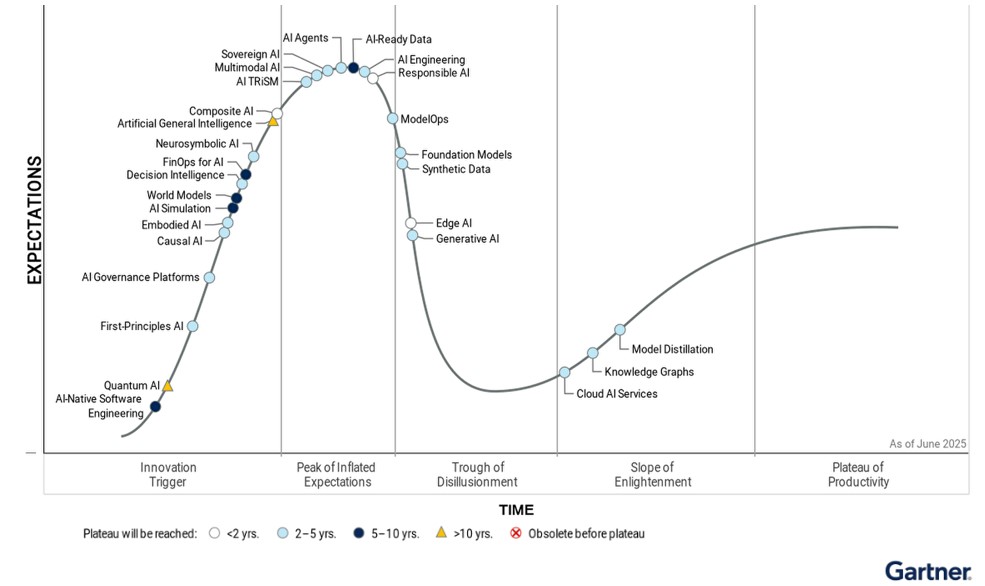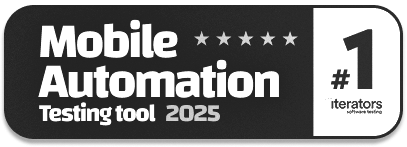Gartner Hype-Cycle for AI 2025: What the Future Holds in 2026?
|
|
Artificial Intelligence (AI) has now crossed the threshold of tech obsession to become a business enabler. But like any new technology wave, it follows a familiar pattern of hype, disappointment, and eventual growth. Gartner’s Hype Cycle for Artificial Intelligence, 2025, serves as a timely map of how organizations are planning to navigate this ever-shifting terrain ahead. As AI becomes more embedded in automation, creativity, and decision-making, organisations need to know where each innovation is on the relative continuum of maturity.
The Hype Cycle for the year 2025 indicates a move away from the undifferentiated enthusiasm towards Generative AI (GenAI) to base technologies necessary for sustainable, scalable delivery of AI. As they move from pilot projects to organization-wide deployment, companies are facing both the promise and peril of widespread AI adoption, a lack of governance, data crunching problems, and, most importantly, skill gaps.
In the meantime, new frontiers for intelligent automation are being promulgated with novel areas, including AI agents and AI-native software engineering.
| Key Takeaways: |
|---|
|
Understanding the AI Hype Cycle
Gartner’s Hype Cycle provides a visual treatment of the maturity and adoption of technologies and applications, and how they are potentially relevant to solving real business problems and exploiting new opportunities. It allows companies to monitor innovation from early discovery through to widespread commercialization and use. This curve can be divided into five stages:
- Innovation Trigger: Innovation is initiated by technological change or an idea that sparks an initial interest and proof-of-concept stories, but it has not yet become commercially viable. Read: Mastering MVP Testing: Implementing Proven Strategies for Success.
- Peak of Inflated Expectations: Some early publicity produces success stories, often accompanied by scores of failures or overpromises.
- Trough of Disillusionment: Failures, unmet expectations, and technical limitations cause waning interest and skepticism.
- Slope of Enlightenment: Second-generation technologies emerge as organizations refine use cases and gain practical understanding.
- Plateau of Productivity: The technology becomes mainstream, delivering tangible benefits and measurable outcomes.
Looking to 2025 and beyond in 2026, Gartner’s analysis positions several key transformative technologies across these stages, including generative AI, foundation models, and synthetic data at the cutting edge. Where AI-native software engineering becomes foundational for the first time. The shift reflects a maturing market in which hype loses its power to practical application, scalability, and governance.
From Hype to Reality: The 2025 Landscape of AI Maturity
In 2024, hype for Generative AI swept through organizations. Yet, the 2025 Hype Cycle represents something of a watershed moment. Now, the AI pioneers are looking at operational viability, risks, and reproducible results-not just simply experiments. The report points to a larger industry epiphany: AI progress is less about isolated innovation and more about building infrastructure with staying power.

It’s clear from the graph that Generative AI is starting to fall into the Trough of Disillusionment, in stark contrast with enabling technologies like ModelOps, AI-ready data, and AI engineering that are on their way up the Slope of Enlightenment. This marks a pivot from curiosity to consolidation, from “what can AI do” to “how can we make AI work efficiently and safely at scale.”
The Emergence of AI Agents: Intelligent Autonomy and Its Challenges
One of the biggest trends is the rise of AI agents: autonomous or semiautonomous systems that perceive, decide, and act by operating in digital or physical environments. AI agents are rapidly progressing from the era of static chatbots to multi-agent systems working together to accomplish collective goals.
From Automation to Autonomy
Compared with the conventional automation scripts, AI agents perform in terms of advanced reasoning, multimodal understanding, and adaptive learning. For instance, AI agents can oversee workflows, negotiate among APIs, or optimize supply chain logistics. Utilization of composite AI, i.e., a combination of multiple models, with broadened applicability, has been introduced. Read: Agentic AI vs. AI Agents vs. Autonomous AI: Key Differences.
Security, Governance, and Trust Barriers
While AI agents show promise, there are issues with trust and control. Most organizations are uncomfortable running automated agents with no human oversight for fear of errors and imagery hallucination that could lead to data leakage or ethical issues. Moreover, these systems introduce a new attack surface, sparking worries about access control, decision transparency, and error reproduction. Read: AI Compliance for Software.
Organizational Readiness for AI Agents
AI agents now sit at the Peak of Inflated Expectations, thanks to overhype around autonomous enterprise workflows. That said, the path to maturity should be paved with strong governance models, AI observability, and collaboration among engineering, data science, and risk management departments, Gartner warns.
The Rise of AI-Ready Data
Data has long been recognized as the fuel of AI, but in 2025, businesses are finding out that not all data is appropriate for AI.
AI-ready data was a key mover this year on the Hype Cycle by Gartner, currently sitting at the Peak of Inflated Expectations, an indicator that while there are high expectations, implementation is complex.
Defining AI-Ready Data
AI-ready data is defined as datasets that are suitable for AI work, having satisfied requirements for quality, completeness, relevance and ethical soundness. However, 57% of companies acknowledge their data is enterprise-grade at best. This lack of trust makes it difficult for them to put successful models into production, leading to governance issues and decreased AI ROI.
The Data Modernization Imperative
For scalable AI, organizations need to update their data pipelines, governance structure, and the integration fabric. This means implementing data fabrics, and or data meshes to enable context awareness and real-time access. Synthetic data generation, a technology raised by Gartner as an essential innovation is also being adopted by enterprises to help supplement datasets and address privacy challenges.
Synthetic Data: Fueling AI Innovation Responsibly
Artificial data, that is, artificially generated sets of examples imitating real-world information, have become essential to AI experimentation. It enables companies to train models without seeing sensitive data, enabling privacy/fairness/security-preserving workflows.
Gartner places Synthetic Data, just beside Foundation Models, demonstrating its increasing importance for model training, bias correction, and simulation. Salted with ModelOps and AI engineering, synthetic data is the framework for ethical, efficient AI experimentation, and deployment.
The Debut of AI-Native Software Engineering
The addition of the 2025 Hype Cycle most importantly centers on AI-native software engineering, a fundamental change in how we build, evolve, and manage software. It’s a collection of development practices that are designed to optimize the app dev process by integrating intelligence, at scale and in an ongoing way, throughout the software lifecycle.
From AI-Augmented to AI-Native Development
Where the initial wave of AI-assisted coding was predominantly based on tools such as GitHub Copilot or Tabnine, making recommendations, AI-native engineering creates a future where AI independently completes entire chunks of software development. This process consists of tasks ranging from requirement analysis to code generation to testing and deployment, making engineers orchestrators of intelligent systems rather than line-by-line coders.
The Shift in the Developer Role
AI-native development repurposes the job of engineers; prioritizing critical thinking, creativity, and human supervision as it were over everyday technical implementation. Developers will be challenged to interpret the AI recommendations, check for consistent logic, and compliance.
Risks and Complexities
Yet AI-native engineering also exposes aggregated risks. Multi-agent workflows, model non-determinism, and AI hallucinations can cause a domino effect on software failures. Security risks could grow as innovative technologies network together. Gartner points out that this move is unavoidable, but responsible AI design principles must support it at every stage of the AI-native lifecycle.
This debut is a teachable moment in the history of software engineering analogous to the way DevOps revolutionized IT a decade ago. AI-native design could be the next decade’s foundation in digital product innovation.
Investing in Foundational AI Enablers
As excitement around experimental AI is being tempered amongst organizations, focus is heading towards the building block enablers of scalable and secure AI delivery. Gartner’s 2025 Hype Cycle highlights AI Engineering and ModelOps as the cornerstone of Enterprise AI systems, professional practices meant to drive standardization, operationalization, preservation of impact, and sustainable value.
AI Engineering: Building Sustainable Infrastructure
AI engineering is the discipline of building reliable, robust AI systems that are the result of disciplined processes around data, model, and code. It allows companies to develop great AI investment portfolios, compatible with the corporation’s IT environment.
Beyond 2025, AI engineering will be the foundation of scaling AI across domains. By prioritizing versioning, testing, monitoring and automation it enables the delivery of AI systems that are flexible and robust. For many businesses, this is a shift from AI as an innovative concept to AI as a utility.
ModelOps: From Model Development to Production at Scale
Model Operationalization or ModelOps is now one of the most significant enablers of AI maturity. It oversees AI and decision models’ entire life cycle, from being trained and validated to being deployed and monitored all the time. ModelOps facilitates standardization, compliance, and scalability. As enterprises run hundreds of AI models, manual management becomes untenable. ModelOps frameworks enable the automation pipelines, monitoring dashboards, and governance layers needed to ensure consistency and traceability.
Gartner expects ModelOps to reach the Plateau of Productivity within a few years, symbolizing its central role in transforming experimental models into production-grade systems.
Edge AI and the Convergence of Intelligence at the Periphery
Edge AI, also a major spotlight of the 2025 Hype Cycle, indicates intelligence continuing to move out from cloud centralization to the edge in devices. With local data processing, Edge AI reduces latencies, protects privacy, and offers immediate decision-making for applications such as autonomous vehicles, health monitoring devices, and smart factory equipment. Read: Edge AI vs. Cloud AI.
The Case for Decentralized Intelligence
With IoT systems growing larger, AI at the edge is a more bandwidth and low-latency-friendly alternative to central AI processing. Edge AI solves these problems by integrating low-power AI models in sensors, cameras or embedded systems. This process decentralizes the processing, in compliance with new data-sovereignty laws that require data to be processed locally.
Read: IoT Automation Testing Guide: Examples and Tools.
Integration with Generative and Foundation Models
The combination of Edge AI and Foundation Models creates a new family of hybrid systems. Generative models can now be deployed at the edge, enabling use cases such as context-aware assistants and predictive maintenance. For such organisations embracing Edge AI, focus must remain on model compression, adaptive learning, and federated architectures in order to retain performance efficiencies.
Gartner predicts that Edge AI will be more widely adopted over the next five years. It’s been identified as one of the most strategic investment areas for the long term.
Generative AI: Entering the Trough of Disillusionment
Generative AI was on the front pages every day in 2023 and 2024, and still is. It threw millions at GenAI projects, playing with chatbots, content generation and productivity boosts. But by 2025, GenAI will enter the Trough of Disillusionment, according to Gartner.
This stage does not represent a downturn, but a much-needed recalibration, the moment when inflated expectations give way to the implementation realities.
The Investment Paradox
According to Gartner’s findings, the average company invested $1.9 million in GenAI projects in 2024, but less than 30% of CEOs were happy with their returns on these investments. Low-maturity companies were unlikely to find the right use cases due to limited understanding of how AI could be used, and high-maturity ones faced scale and literacy issues. This misalignment reveals an important reality: investment is not enough to transform. Read: AI and ML Tops 2025 Agenda for APAC CIOs.
The Trust and Governance Challenge
Businesses are increasingly under pressure to guarantee AI that is ethical, explainable, and compliant. The potential for hallucinations, bias, and fairness issues has garnered responses from lawmakers proposing stronger regulations of GenAI. At the same time, organizations are setting up internal AI governance boards to oversee model transparency and risk reduction. The governing challenge is two-fold: to manage the AI itself and to change external regulations on its acceptable use. Read: What is Explainable AI (XAI)?
Talent and Literacy Gaps
Even mature organizations are obstacles to GenAI literacy. Employees also need to know how to interpret and validate AI outputs, but they must engage with it. The future of those people is “wired for creation,” with roles like AI ethics managers, model auditors, and outbreak-prompt engineers that combine creativity with accountability.
Nevertheless, Generative AI is paradigm-shifting. Moving into the Trough of Disillusionment indicates that this technology is maturing, and organizations are waking up to how they should properly implement it, aligning it more closely with business objectives and incorporating AI strategies into overarching digital strategy.
The Strategic Shift: From Experimentation to Scale
The trending theme throughout Gartner’s 2025 is the organization-wide scaling of AI. The age of pilot projects and proofs-of-concept is passing; organizations must build sustainable, trusted, value-creating AI systems.
Governance as a Growth Enabler
Responsibilities for AI governance have transformed from a required process to a strategic capability. Forward-thinking organizations are developing AI operating models that blend governance into innovation, so that ethical norms, transparency, and accountability drive (and don’t limit) progress. ModelOps are increasingly integrated within governance models, which makes it possible to audit the logic of each model in real time.
The Role of AI Centers of Excellence (AI CoEs)
To map out this scaling journey, many firms are setting up AI Centers of Excellence, similar to Testing Center of Excellence (TCoE). These CoEs serve as the focal point for driving AI best practices, working with others in your company to identify areas where adopting AI can deliver new orders of magnitude better results and create a lasting competitive advantage. They bring uniformity to how models are deployed, performance is being monitored, and ethical considerations are addressed at the business.
Reimagining the AI Workforce
Scaling AI also requires rethinking workforce design. The next generation of AI professionals will span roles such as AI model steward, prompt designer, AI auditor, and AI product manager. These hybrid roles blend business acumen with ethical and technical insight, ensuring that AI initiatives align with corporate objectives.
Challenges on the Road to AI Maturity
Despite clear progress, organizations face substantial obstacles in the transition from experimentation to enterprise-grade AI. Gartner’s 2025 Hype Cycle highlights three critical areas that demand attention:
- Regulatory Fragmentation: Governments worldwide are introducing AI acts and ethical guidelines that vary by jurisdiction. Compliance complexity may slow innovation unless organizations adopt adaptive governance models.
- Data Quality and Integration: Without AI-ready data, models fail to generalize. Enterprises must invest in data observability, lineage tracking, and semantic modeling to ensure data fitness and trustworthiness.
- Operational Complexity: As the number of deployed models grows, so does the need for automated MLOps and ModelOps frameworks. Manual oversight will no longer suffice; scalable automation is essential.
- Security and Trust: Expanding AI ecosystems introduce new attack vectors, including adversarial inputs, data poisoning, and model theft. Building secure, interpretable AI pipelines is now a non-negotiable aspect of responsible adoption. Read: What is Adversarial Testing of AI.
A Vision Beyond 2025
Scaling AI will also require reimagining the workforce design. We will see a new generation of AI roles emerge, including the career make-up of the AI model steward, prompt designer, AI auditor, and AI product manager, etc. These roles mix business savvy with moral and technical wisdom to guide AI projects in the direction of corporate objectives.
- Maturity through ModelOps and AI Engineering: Enterprises that standardize their AI development pipelines and enforce governance through ModelOps will achieve measurable ROI and resilience. Integrating engineering rigor into AI design, encompassing testing, validation, and retraining, will define the leaders of the next phase.
- Democratization of AI Capabilities: AI accessibility will continue to expand through low-code and no-code interfaces, enabling business users to co-create AI solutions. The convergence of AI and software engineering will democratize innovation, fostering organization-wide AI literacy.
- Continuous Evolution of Foundational Models: Foundation Models, large-scale pre-trained models underlying GenAI, will evolve toward domain-specific specialization, reducing cost and bias. They will form the core digital infrastructure upon which intelligent enterprises operate.
- Human-Centric AI: The long-term success of AI depends not on replacing humans but on augmenting human intelligence. Organizations emphasizing interpretability, empathy, and collaboration between humans and machines will build more resilient and ethical AI ecosystems.
Wrapping Up
The 2025 Hype Cycle for Artificial Intelligence represents the shift of AI from being an experimental discipline to a disciplined scaling one. Generative AI entering the Trough of Disillusionment is a course correction desired consequence, not a defeat. Core enablers such as ModelOps, AI-ready data, and AI engineering are now what define enterprise maturity. The real leaders will be those who develop a happy marriage of innovation and governance, injecting intelligence into every digital process.
| Achieve More Than 90% Test Automation | |
| Step by Step Walkthroughs and Help | |
| 14 Day Free Trial, Cancel Anytime |












